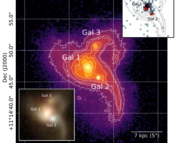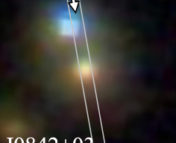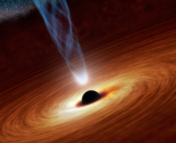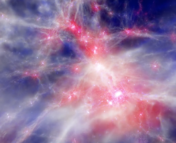Paper Title: Hidden AGN in dwarf galaxies revealed by MaNGA: light echoes, off-nuclear wanderers, and a new broad-line AGN
Authors: Mar Mezcua and Helena Domínguez Sánchez
First Author’s Institution: Institute of Space Sciences (ICE, CSIC), Campus UAB, Carrer de Magrans, 08193 Barcelona, Spain; Institut d’Estudis Espacials de Catalunya (IEEC), Carrer Gran Capità, 08034 Barcelona, Spain
Status: Published in ApJ. Open access on arXiv
Beneath the radiant tapestry of massive galaxies that thread our universe, lesser-known cosmic entities lurk – dwarf galaxies. Weighing in with stellar masses below 3 billion solar masses, these low luminosity celestial islands barely tip the scale (many individual supermassive black holes outweigh them)! Furthermore, despite being the most abundant type of galaxy in the universe, their formation and evolution are still not very well understood.
Small But Mighty!
Active Galactic Nuclei (AGN) glow vibrantly in the darkness of space. Fueled by the rapid accretion of matter onto compact black holes within galactic cores, they can outshine the collective starlight of their host galaxies. Additionally, their powerful outflows can heat and disperse cold molecular gas, which astronomers believe may quell star formation and regulate galactic growth.
Most AGN are suspected to feature supermassive black holes (SMBHs; black holes with masses greater than one million solar masses) at their centers; however, today’s authors present exciting evidence, in tandem with previous studies that have uncovered hundreds of AGN within dwarf galaxies that harbor lower mass black holes, that is compelling astronomers to return to the drawing board.
The Quest for Dwarf AGN
Previous studies of AGN in dwarf galaxies primarily relied upon single-fiber (3 arcsecond aperture) spectroscopic measurements taken at the galactic center (i.e. the Sloan Digital Sky Survey). Prominent emission lines are identified in these spectra and their flux ratios plotted in a BPT diagram (see this Astrobite article for more). Depending on a galaxy’s location on a BPT diagram, the primary emission source for each galaxy is classified as star formation, AGN, Low-Ionization Nuclear Emission-Line Regions (LINERs; emission that can originate from AGN and hot old stars), or a composite of multiple ionization mechanisms.
However, these single-fiber measurements are often biased towards central AGN and can fail at AGN identification if there is abundant star formation in the center of a galaxy. Moreover, strong host galaxy light can diminish AGN signatures.
Alternatively, spatially resolved spectroscopic measurements can provide more definitive evidence of AGN activity. In particular, integral field unit spectroscopy can trace emission line features from varying physical regions of a galaxy (Figure 1).
The SDSS/ Mapping Nearby Galaxies at APO (MaNGA) survey is a critical step forward in this direction. This survey will provide IFU data for nearly 10,000 galaxies by the end of 2020, which will make it the largest such catalog. Today’s authors leverage MaNGA and conduct the largest dedicated study of dwarf galaxies that host AGN within the survey.
Filtering the Data
Of the 4,718 sources they investigate, the authors categorize 1,609 sources as dwarf galaxies after imposing an upper mass cutoff of 3 billion solar masses. Subsequently, they examine a spectrum of each spatial pixel, or spaxel, for each dwarf galaxy to conduct a spatially resolved BPT analysis. As shown in Figure 1, the BPT diagram plots the [OIII]λ5007/Hα flux ratio against the [NII]λ6583/Hβ flux ratio. The location of each spaxel on the diagram determines the primary emission mechanism (i.e. star-forming, AGN, LINER, or composite) at each galactic position.
Figure 1: Left – BPT Diagram showcasing emission line classifications (i.e. star-forming, AGN, LINER, or composite) for each spaxel for a sample dwarf galaxy (8456-3704). The black square represents the median BPT location of the spaxels that are classified as AGN/ LINER. The gray square marks the SDSS single fiber location. Center – physical distribution of BPT spaxels. Empty squares trace the IFU coverage and gray squares indicate spaxels with a continuum SNR greater than 1. Right – SDSS composite image. The pink hexagon shows the IFU coverage.
Figure 2: Left – stacked spectrum (blue) of all galaxy spaxels (gray) that are located in the AGN/LINER region of the BPT diagram. The emission line component is shown in red. Right – zoom-in of the stacked spectrum in the spectral region of the emission lines used for the BPT diagram.
To resolve the fact that LINERs are not exclusively linked to AGN activity, the authors utilize the WHAN diagram to further eliminate non-AGN from their sample (Figure 3). The diagram identifies sources with Hα equivalent widths < 3 Å, the traditional threshold for AGN detection. However, the authors relax this requirement slightly to avoid eliminating any borderline AGN and evoke a cut-off of 2.8 Å. The final catalog that results from this step nets 37 dwarf galaxies that host an AGN within MaNGA.
Figure 3: WHAN diagram for the initial 102 dwarf galaxies with their median BPT spaxels classified as AGN/ LINER. Using an Hα equivalent width threshold of 2.8 Å, the final sample of AGN dwarf galaxies is reduced to 37. The color bar denotes the median specific star formation (star formation rate per unit stellar mass) of the AGN/LINER spaxels.
Dwarf AGN Unveiled
Of the 37 dwarf galaxies which host AGN, the authors analyze 35 with available SDSS single fiber spectra. They report only 12 AGN of the 35 are classified as such from the single fiber spectra; the IFU measurements thus reveal 23 additional AGN that were either labeled as star-forming, composite, or quiescent (SNR of BPT emission lines < 3) with the single fiber method – a true testament to the benefit of spatially resolved spectra.
So why did these single fiber measurements fail? To address this, the researchers explore the photometric properties of their sample. Doing so, they find that the dwarf galaxies feature relatively low star formation, as determined by the B-V color index (the brightness profiles of the galaxies were redder than anticipated). In addition, the single-fiber measurements of the dwarf galaxies indicate that only six of the 37 IFU AGN are star-forming. These results collectively suggest that suppression of AGN signatures is unlikely due to emission from star formation. Rather, it is likely that the missed AGN are either off-nuclear or currently inactive.
Using the spatially resolved BPT diagrams, the authors analyze the non-central AGN spaxels and find diffuse, elongated, and generally symmetric emission. These characteristics are consistent with light echoes – the ghostly remnants of previously active AGN. Yet, they cannot rule out the possibility that these are signatures of active off-nuclear AGN. To resolve this confidently, the authors express their intention to conduct follow up observations with high-resolution radio and X-ray wavelengths using FIRST and Chandra. These measurements can be coupled with models to better expose AGN activity.
Finally, the investigators compute the masses of the AGN black holes in their sample and initially determine 14 intermediate-mass black holes (IMBHs; black holes with masses between one hundred and a million solar masses) using the MBH– σ scaling relation with a modified low mass dependency. If unmodified, they discover only three IMBHs in their sample. The remaining black holes in both cases are deemed SMBHs. These results suggest that dwarf galaxies with AGN can host many types of black holes and that the fundamental nature of these galaxies requires further investigation.
Looking Forward
Today’s authors have exemplified the extraordinary capabilities of IFU spectroscopy. Utilizing the MaNGA catalog, they have uncovered 23 AGN that would not have been detected with a single fiber spectroscopy.
Ultimately, by analyzing AGN in dwarf galaxies, we may uncover how IMBHs and dwarf galaxies co-evolve. We may also determine if IMBHs play a role in seeding the growth of SMBHs!




